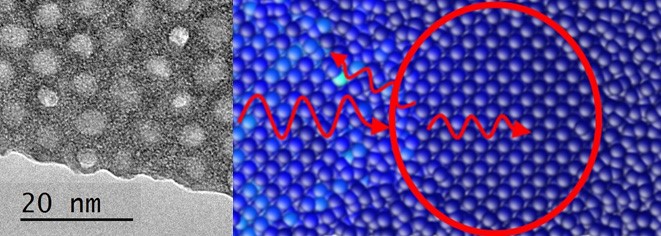
Transport thermique : nanocomposites métalliques amorphe/cristal
Amani Tlili, Stéphane Pailhès, Régis Debord, Beatrice Ruta et Valentina Giordano (equipe (nano)matériaux pour l’énergie ), en collaboration avec des collègues de Grenoble et de Lyon, ont publié un article intitulé "Thermal transport properties in amorphous/nanocrystalline metallic composites: A microscopic insight" dans la revue Acta Materialia .

Thermal transport in amorphous-nanocrystalline metallic nanocomposites
Amani Tlili, Stéphane Pailhès, Régis Debord, Beatrice Ruta and Valentina Giordano (team NanoMaterials for Energy), together with colleagues from Grenoble and Lyon, have published an article entitled"Thermal transport properties in amorphous/nanocrystalline metallic composites: A microscopic insight" dans la revue Acta Materialia .
Les verres métalliques ont des propriétés mécaniques, élastiques et électroniques exceptionnelles mais leur développement à grande échelle est limité par leur nature cassante. A l’échelle microscopique, cette fragilité est associée à la formation de bandes de cisaillement propagatives qui sont à l’origine de fissurations dans le matériau. Dans le but de bloquer leur propagation, une idée est d’introduire des nano-cristallites dans le verre. Cette nano-cristallisation partielle du verre s’obtient de manière contrôlée par des procédés thermodynamiques simples. Les auteurs ont étudié expérimentalement l’évolution des propriétés de transport thermique et électronique par des mesures macro- et microscopiques d’un tel verre composite en fonction du taux de nano-cristallites. Ils montrent qu’une faible fraction cristalline suffit à dominer la conduction de la chaleur, alors que le transport électrique est déterminé par la composante majoritaire dans le composite.
Metallic glasses are extremely renowned for their exceptional mechanical elastic and electronic properties. Still, their widespread use is limited by their intrinsic brittleness, due to the propagation of microscopic shear bands, giving raise to macroscopic fracture. A promising way for hindering shear bands propagation, consists in introducing nanocrystallites in the glass, via controlled thermodynamical processing. The authors have performed an experimental investigation of the evolution of thermal and electronic transport properties in such a composite, as a function of the crystallite content. They report that a weak crystallites content is enough for strongly affecting heat transport, while electronic conduction is still dominated by the main phase in the composite.
12/10/2017


















